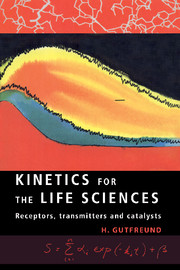Book contents
- Frontmatter
- Contents
- Preface
- 1 The time scales of nature: a historical survey
- 2 Some mathematical introductions
- 3 Elementary kinetic equations: ground rules
- 4 Kinetic analysis of complex reactions
- 5 Transient kinetics of enzyme reactions
- 6 Chemical relaxation phenomena
- 7 Factors affecting rates of reactions
- 8 The role of light in kinetic investigations
- References
- Index
6 - Chemical relaxation phenomena
Published online by Cambridge University Press: 08 January 2010
- Frontmatter
- Contents
- Preface
- 1 The time scales of nature: a historical survey
- 2 Some mathematical introductions
- 3 Elementary kinetic equations: ground rules
- 4 Kinetic analysis of complex reactions
- 5 Transient kinetics of enzyme reactions
- 6 Chemical relaxation phenomena
- 7 Factors affecting rates of reactions
- 8 The role of light in kinetic investigations
- References
- Index
Summary
Applications of relaxation kinetics
Definition of relaxation
Apart from brief excursions into steady states all the kinetic phenomena discussed in this volume are, in principle, relaxations from one state to another. These relaxations can be between two equilibrium states or two steady states, or between an equilibrium and a steady state. They are the consequences of the perturbation (by a step or oscillations) of an intensive parameter (temperature, pressure or electric field), or a mechanical parameter, as for instance in the rapid length changes of muscle fibres (Huxley & Simmons, 1971). Concentration jumps can also be used to initiate relaxation processes. Other examples taken from common experience are the visco-elastic relaxation in response to a change in length or tension and the response of a capacitor to a change in the applied voltage (see section 2.1). There is no sharp distinction between the general use of the terms transients and relaxations. Relaxation analysis can be applied to the response to a perturbation of very complex systems, such as an engineering structure or a physiological system. In connection with the last example it is, of course, very interesting to study the range of response times and recoveries after sensory stimuli. However, this sort of problem has already been discussed in chapter 4 in terms of consecutive reactions and the enumeration of the number of steps of sequential processes and transients. Eigen (1968) used the term ‘chemical relaxation spectrometry’ for methods involving small perturbations (see below for definition of ‘small’) of chemical equilibria by rapid changes of an intensive parameter.
- Type
- Chapter
- Information
- Kinetics for the Life SciencesReceptors, Transmitters and Catalysts, pp. 197 - 230Publisher: Cambridge University PressPrint publication year: 1995



